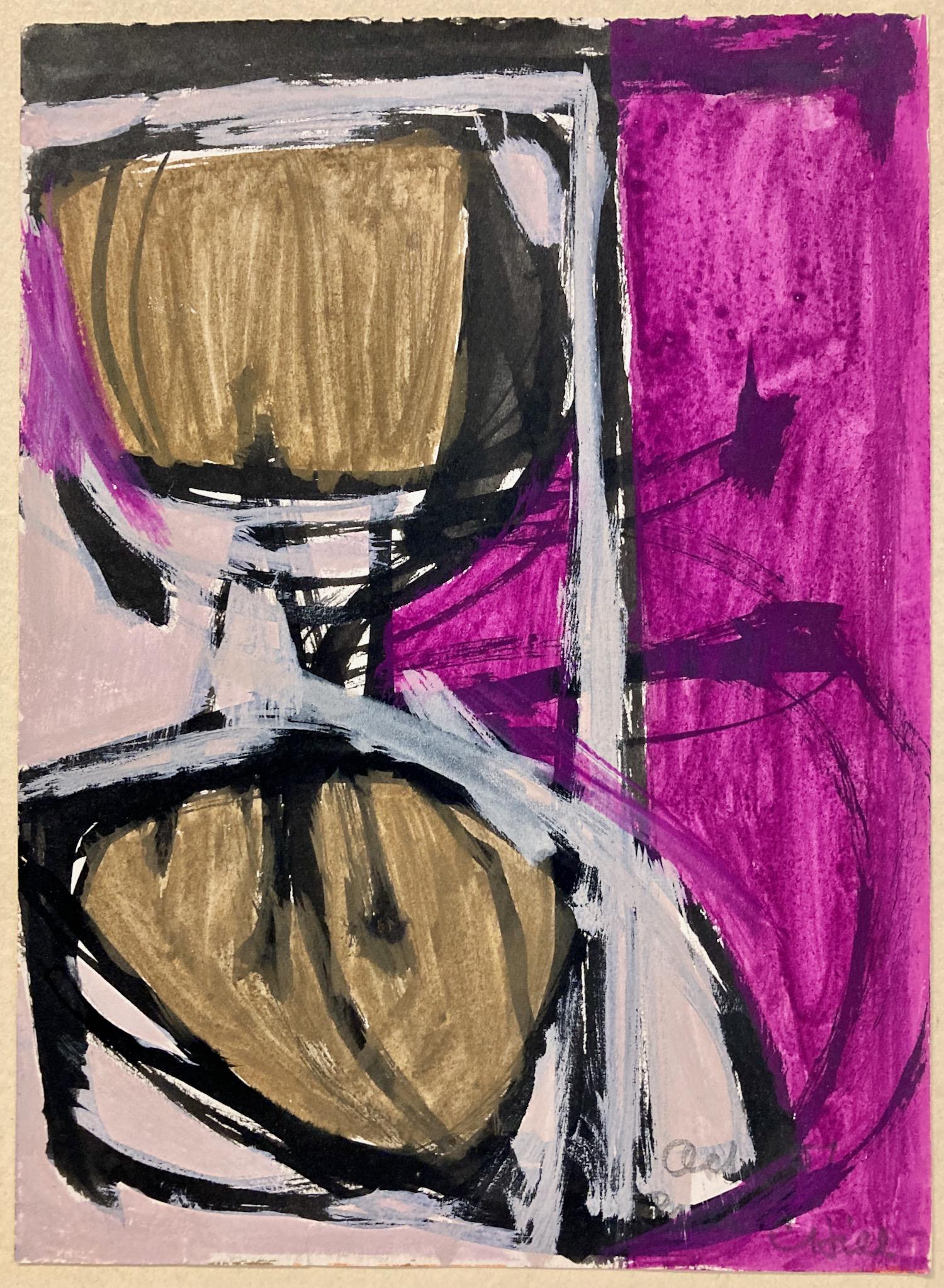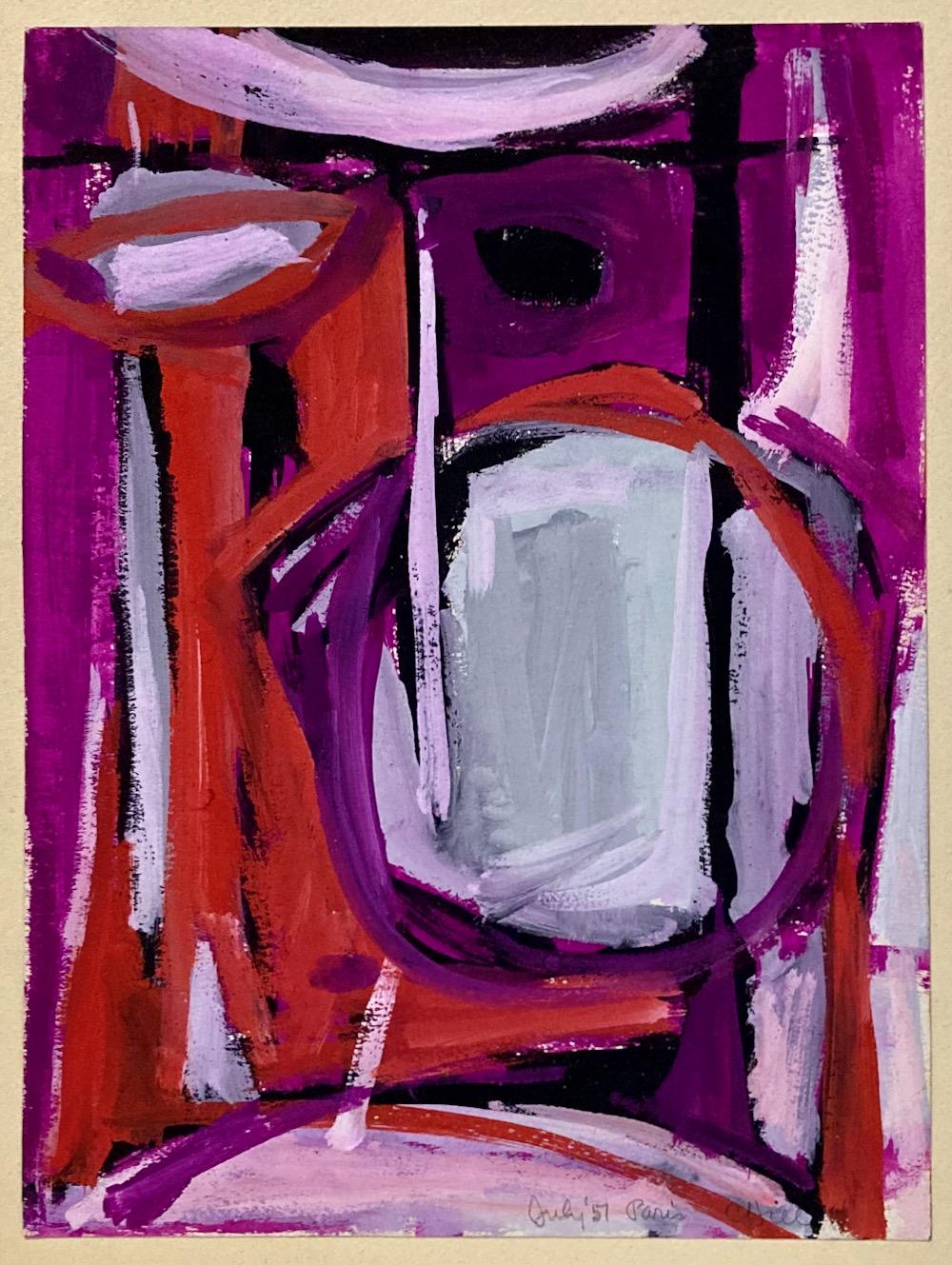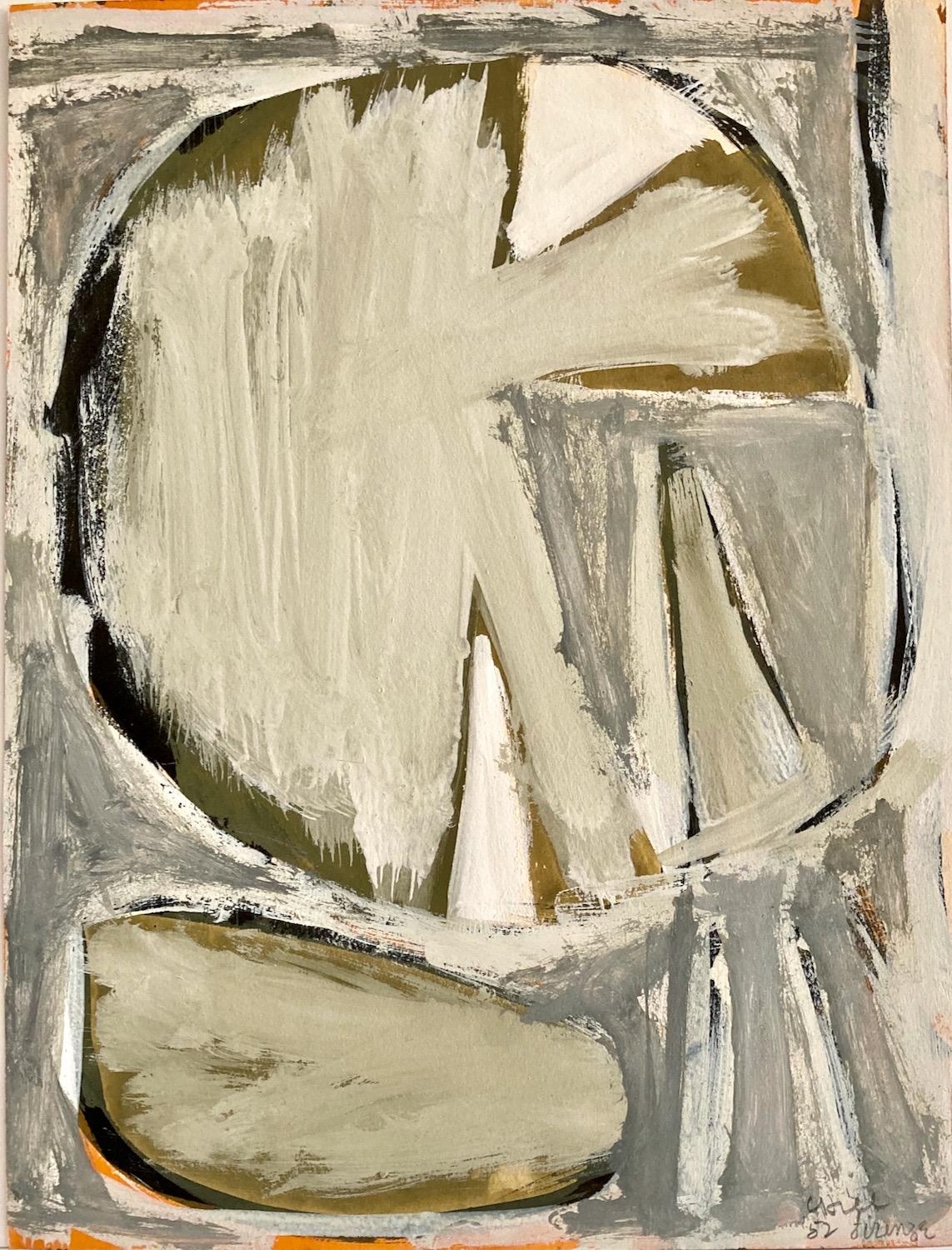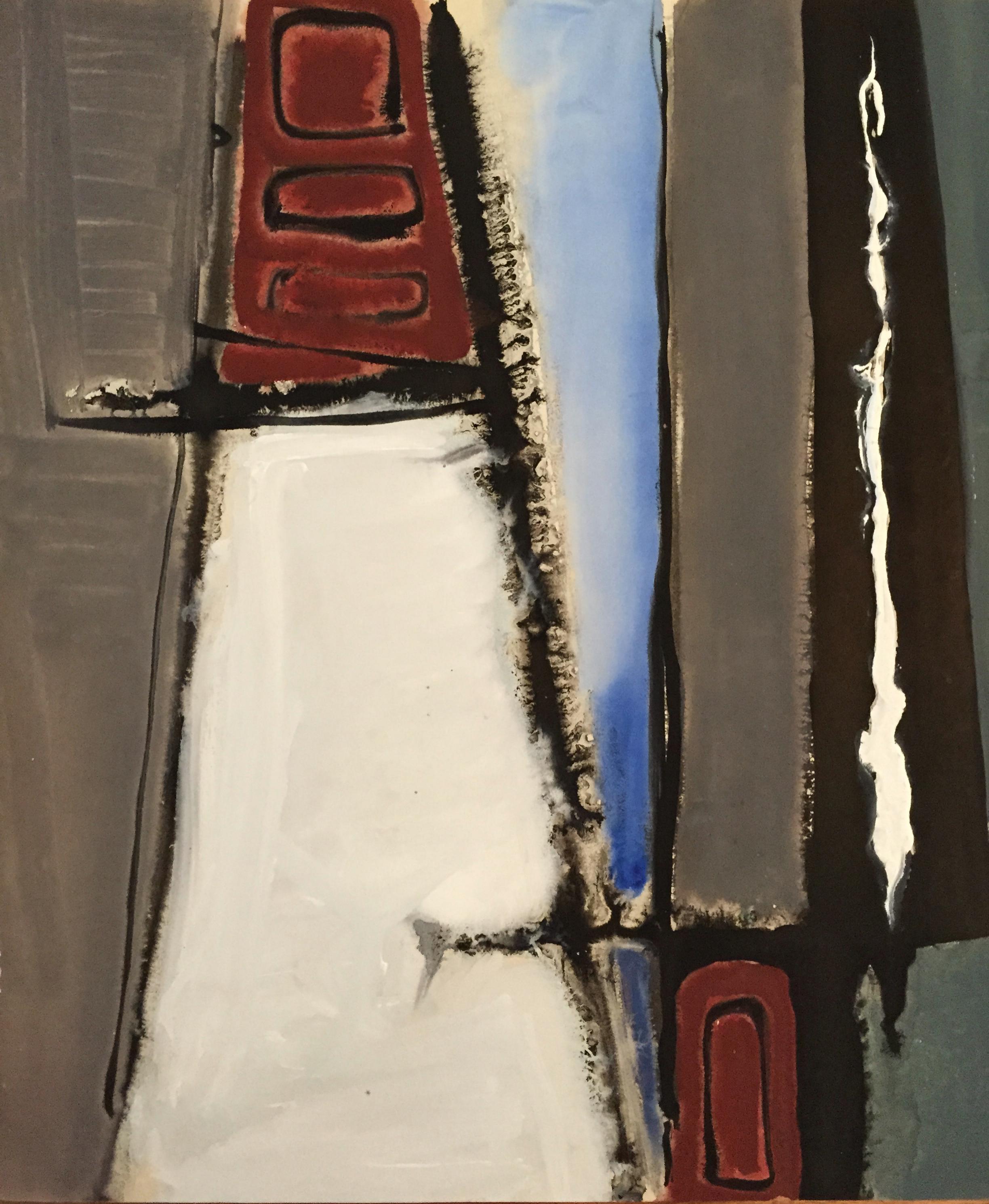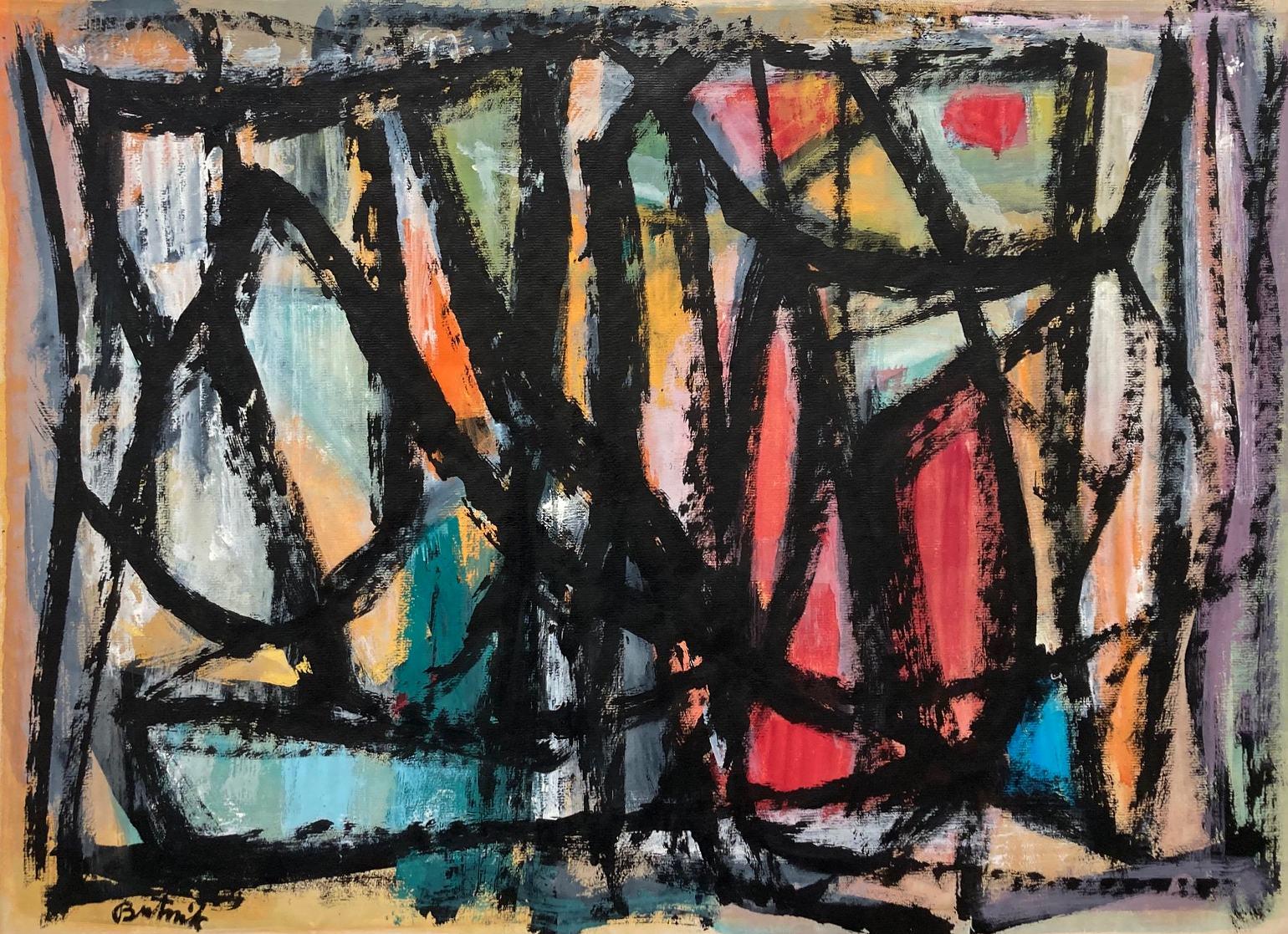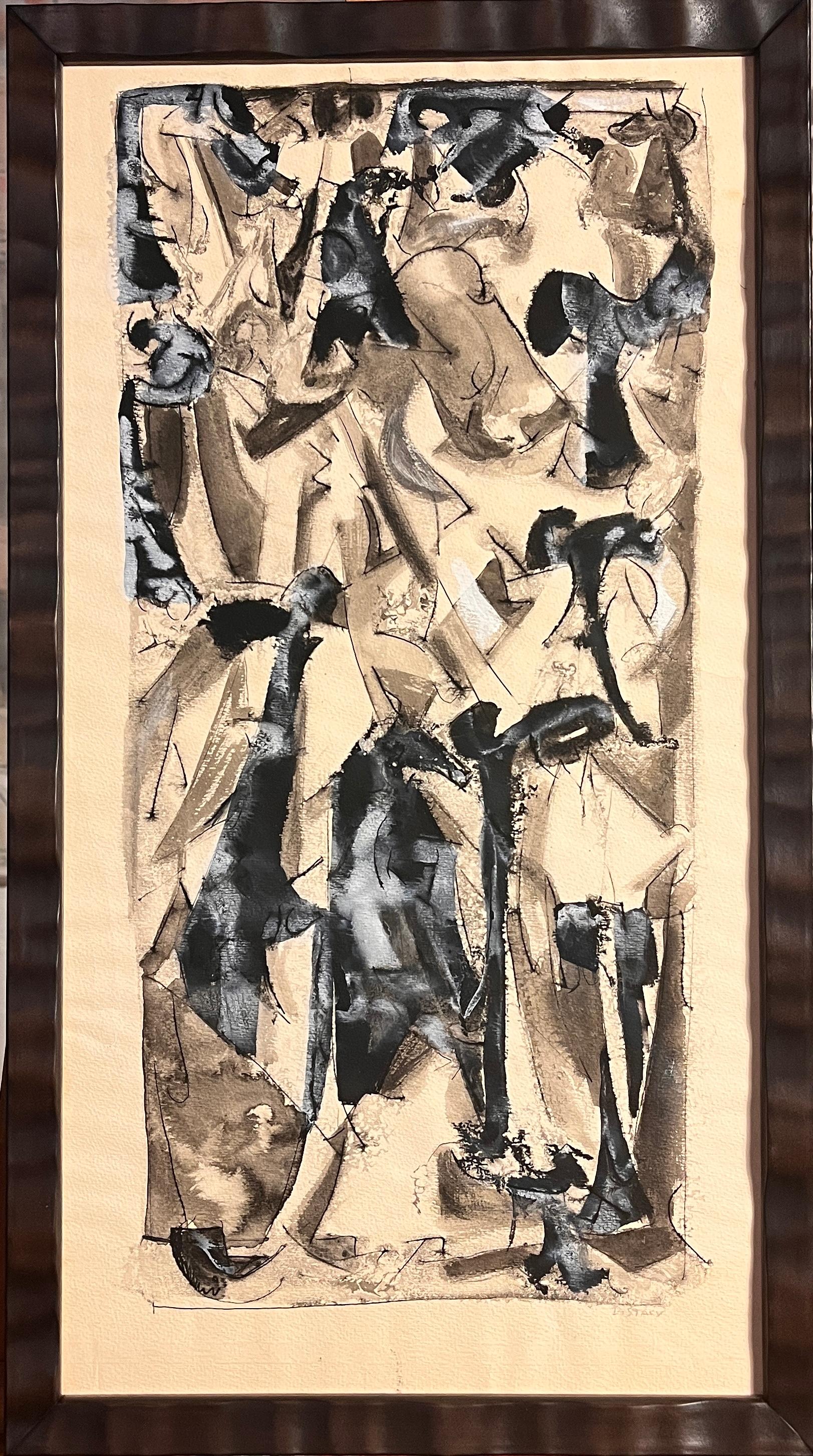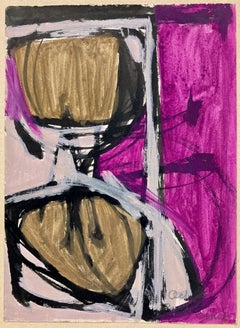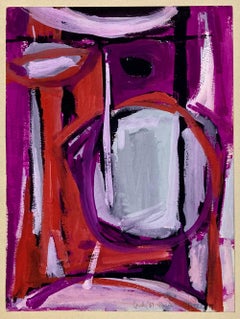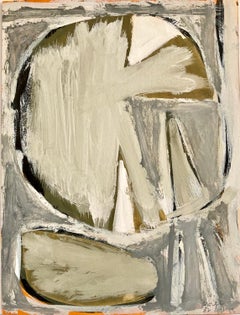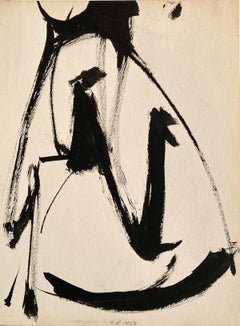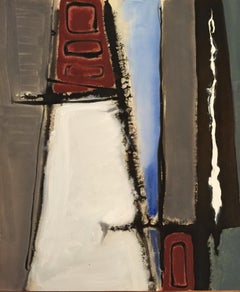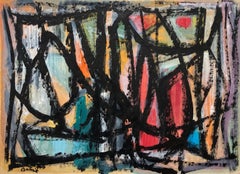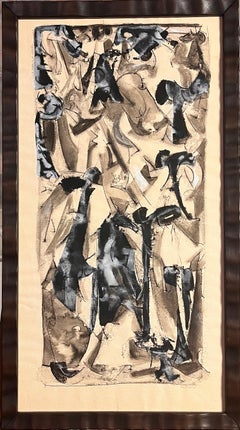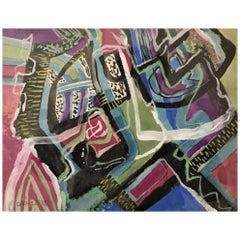Items Similar to Clinton Hill, Paris, Oct., 1951 (France), mid-century abstract gouache drawing
Want more images or videos?
Request additional images or videos from the seller
1 of 6
Clinton HillClinton Hill, Paris, Oct., 1951 (France), mid-century abstract gouache drawing1951
1951
$750
£563.94
€654.87
CA$1,047.36
A$1,161.60
CHF 610.01
MX$14,265.26
NOK 7,722.21
SEK 7,282.15
DKK 4,886.06
Shipping
Retrieving quote...The 1stDibs Promise:
Authenticity Guarantee,
Money-Back Guarantee,
24-Hour Cancellation
About the Item
Clinton Hill (1922-2003), created quintessential mid-century images.
He lived in SoHo, New York, and was a frequent Gallery visitor.
Born in Idaho and raised on a working ranch, he joined the US Navy during World War II and became a commander of a minesweeper in the Pacific. After the war, on the GI Bill, he attended the University of Oregon, Eugene, graduating in 1947. Moving to New York City with his partner Alan Tran, Hill attended the Brooklyn Museum School from 1949 to 1951. In 1951 Hill studied at the Academie de la Grande Chaumiere, Paris, and the Instituto d'Arte Statale, Florence. His first of many one-person shows was at the Zabriskie Gallery, NYC, in 1955. His friend Mark Rothko suggested its title, Ladders and Windows. In 1956 he traveled to India on a Fulbright scholarship. Through his prints, sculpture, books, hand-made objects, and lifetime of experimentation of materials, he pushed the boundaries of Abstraction. He taught at Queens College, NY, for twenty years.
His work is in the collections of the Metropolitan Museum of Art, Museum of Modern Art, Guggenheim Museum of Art, the Whitney Museum of American Art, Brooklyn Museum, and the Albright-Knox Museum of Art, Buffalo, NY, the Smithsonian American Art Museum, Washington, DC, and the Victoria and Albert Museum and the British Museum, London.
Signed, titled, and dated, at lower right corner, in pencil.
- Creator:
- Creation Year:1951
- Dimensions:Height: 7.25 in (18.42 cm)Width: 5.25 in (13.34 cm)
- Medium:
- Movement & Style:
- Period:
- Condition:Mounted to a support sheet. Skinning of the support sheet on the reverse.
- Gallery Location:New York, NY
- Reference Number:1stDibs: LU1410215440872
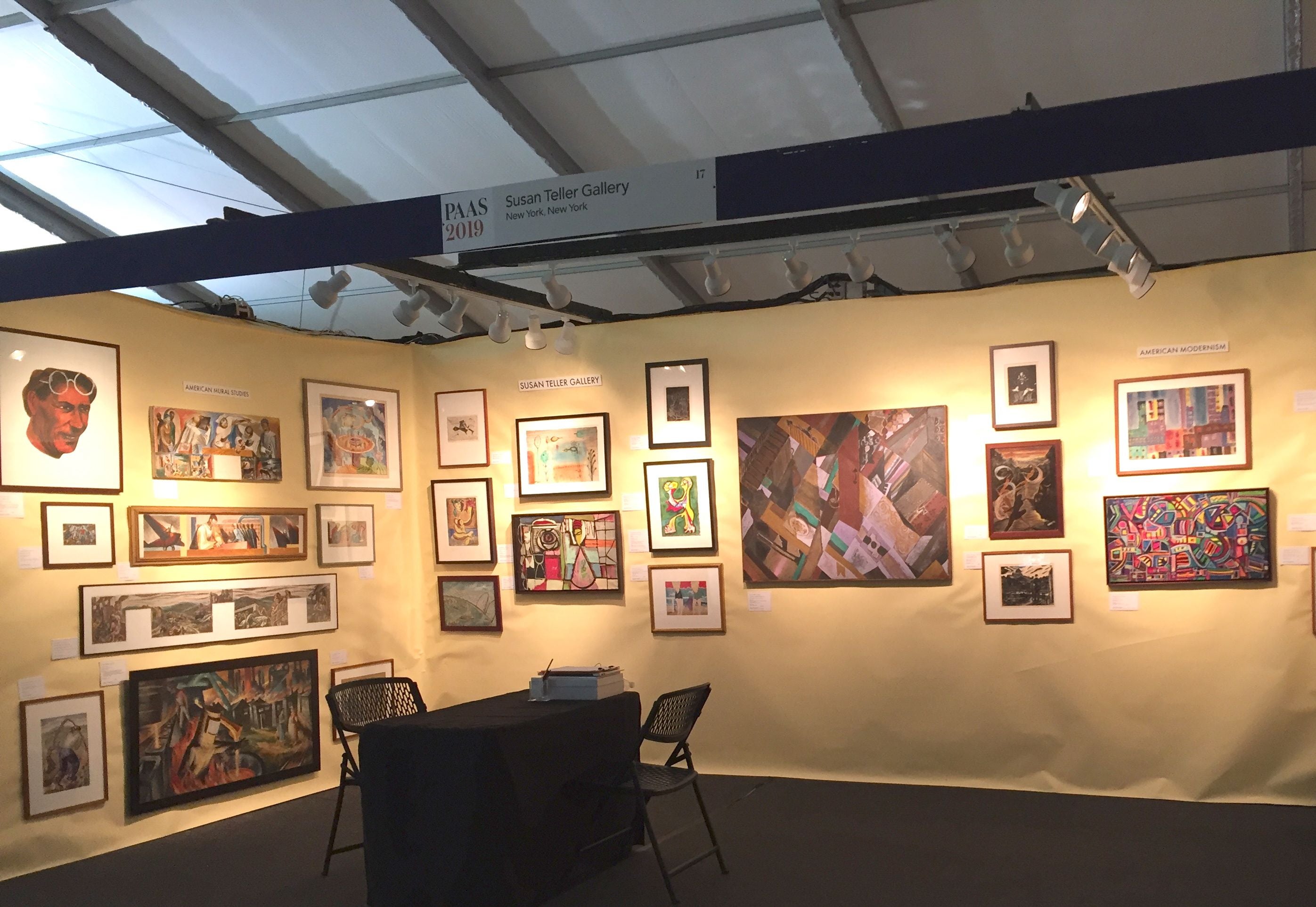
About the Seller
4.9
Platinum Seller
Premium sellers with a 4.7+ rating and 24-hour response times
Established in 1988
1stDibs seller since 2020
122 sales on 1stDibs
Typical response time: <1 hour
- ShippingRetrieving quote...Shipping from: New York, NY
- Return Policy
Authenticity Guarantee
In the unlikely event there’s an issue with an item’s authenticity, contact us within 1 year for a full refund. DetailsMoney-Back Guarantee
If your item is not as described, is damaged in transit, or does not arrive, contact us within 7 days for a full refund. Details24-Hour Cancellation
You have a 24-hour grace period in which to reconsider your purchase, with no questions asked.Vetted Professional Sellers
Our world-class sellers must adhere to strict standards for service and quality, maintaining the integrity of our listings.Price-Match Guarantee
If you find that a seller listed the same item for a lower price elsewhere, we’ll match it.Trusted Global Delivery
Our best-in-class carrier network provides specialized shipping options worldwide, including custom delivery.More From This Seller
View AllClinton Hill, Paris, Oct., 1951 (France), mid-century abstract gouache drawing
By Clinton Hill
Located in New York, NY
Clinton Hill (1922-2003), created quintessential mid-century images.
He lived in SoHo, New York, and was a frequent Gallery visitor.
Born in Idaho and raised on a working ranch, ...
Category
Mid-20th Century American Modern Abstract Drawings and Watercolors
Materials
Gouache
Clinton Hill, Paris, July, 1951 (France), mid-century abstract gouache drawing
By Clinton Hill
Located in New York, NY
Clinton Hill (1922-2003), created quintessential mid-century images.
He lived in SoHo, New York, and was a frequent Gallery visitor.
Born in Idaho and raised on a working ranch, ...
Category
Mid-20th Century American Modern Abstract Drawings and Watercolors
Materials
Gouache
Clinton Hill, Firenze (Florence, Italy), 1952, drawing, landscape/abstraction
By Clinton Hill
Located in New York, NY
Clinton Hill (1922-2003), created quintessential mid-century images. This abstraction references Florence, Italy, where he studied in the early 1950s.
He lived in SoHo, New York, a...
Category
Mid-20th Century American Modern Landscape Drawings and Watercolors
Materials
Gouache
Clinton Hill, (Nude #2), 1950, drawing, figure/abstraction
By Clinton Hill
Located in New York, NY
Clinton Hill (1922-2003), created quintessential mid-century images, but figures are unusual in his work. This is from a very early period. From 1949 to 1951 he attended the Brooklyn...
Category
Mid-20th Century American Modern Landscape Drawings and Watercolors
Materials
Gouache
Clinton Hill, (Nude #1), 1951, drawing, figure/abstraction
By Clinton Hill
Located in New York, NY
Clinton Hill (1922-2003), created quintessential mid-century images, but figures are unusual in his work. This is from a very early period. In 1951 Hill studied at the Academie de la...
Category
Mid-20th Century American Modern Abstract Drawings and Watercolors
Materials
Gouache
Clinton Hill, (Nude #8), 1952, drawing, figure/abstraction
By Clinton Hill
Located in New York, NY
Clinton Hill (1922-2003), created quintessential mid-century images, but figures are unusual in his work. This is from a very early period. In 1951 Hill studied at the Academie de la...
Category
Mid-20th Century American Modern Abstract Drawings and Watercolors
Materials
Gouache
You May Also Like
1950s "Rectangle" Mid Century Abstract Gouache Painting
Located in Arp, TX
Opper Estate
Maroon Abstract
c. 1940-1950's
Gouache on Paper
15" x 18" Unframed
From the estate of Ruth Friedmann Opper & Jerry Opper. Ruth was the daughter of Bauhaus artist, Gustav Friedmann.
San Francisco Abstract Expression
A free-spirited wave of creative energy swept through the San Francisco art community after World War II. Challenging accepted modes of painting, Abstract Expressionists produced highly experimental works that jolted the public out of its postwar complacency.
Abstract Expressionism resulted from a broad collective impulse rather than the inspiration of a small band of New York artists. Documenting the interchanges between the East and West Coasts, she cites areas of mutual influence and shows the impact of San Francisco on the New York School, including artists such as Mark Rothko and Ad Reinhardt. San Francisco's Beat poets...
Category
Mid-20th Century American Modern Abstract Paintings
Materials
Paper, Gouache
A Colorful 1956 Gouache Titled "Sunday in Torromolinos, Spain" by Samuel Butnik
Located in Chicago, IL
A Colorful 1956 Gouache Titled "Sunday in Torromolinos, Spain" by Samuel Butnik. Artwork size: 18" x 25". Archivally matted to: 24" x 30".
Biography...
Category
1950s Abstract Expressionist Abstract Paintings
Materials
Paper, Gouache
1950s "Abstract #4" Ink and Gouache Painting Univ of Paris
By Donald Stacy
Located in Arp, TX
Donald Stacy
"Abstract #4"
c.1950s
Ink & Gouache on paper
10.5x19.5" brown, ripple, wood frame 11.5”x1”x20.75”
Signed in pencil lower right with label on reverse
Came from artist's e...
Category
Early 20th Century Abstract Abstract Paintings
Materials
Paper, Ink, Gouache
$787 Sale Price
25% Off
Rolph Scarlett, Modernist Abstract Composition, Guache on Paper, Ca. 1950’s
By Rolph Scarlett
Located in New York, NY
Artist: Rolph Scarletti (Canadian, 1889 – 1984)
Object: Modernist Abstract Composition
Period: Ca. 1950’s
Medium: Guache on paper, framed
Dimensions (unframed):
Height: 9-1/3”
Width: 12”
Dimensions (framed):
Height: 22-3/4””
Width: 25-3/4”
Rolph Scarlett (Canadian, 1889 – 1984) was a consummate explorer of twentieth-century abstract painting. Never afraid of trying new styles, curious and opinionated, constantly engaged with the world around him while steadfastly aware that he was on his own path and his alone, Scarlett more than once proved to be at the artistic zeitgeist of the eras in which he lived. Exposed very early on to the work of Paul Klee through a chance meeting in Europe with the artist himself, Scarlett took up abstraction with a fervor that never diminished during his long and impressive career. To create something that had never existed before: this was Scarlett’s great cause. And that is what is most obvious when you look at Scarlett’s work—you have never seen anything quite like it.
Scarlett was Canadian-born, came of age in the Midwest, and spent few important years in Hollywood, where he designed stage sets. His work from this early period echoes Klee’s use of color, his confidence in naïve, primitive forms, and his blend of abstraction and figuration. In its flat spatial qualities it prefigures the Indian Space painting of the 1940s by a decade. He moved to New York in 1933 and eventually found his first great patron at the Museum of Non-Objective Painting, directed by Baroness Hilla Rebay and art patron Solomon R. Guggenheim. Guggenheim would collect over 60 works by Scarlett for his collection, more than any other artist outside of Vasily Kandinsky and Rudolf Bauer.
As a frequent exhibitor and lecturer at the Museum of Non-Objective Painting (MNOP), Scarlett honed his sensitive feel for bodies in space and capitalized on his trademark use of bright, vivacious colors into accomplished, perfectly harmonized geometric works. However, Scarlett soon morphed these hard-edged forms into a nuanced expressionistic abstraction which, at its best, seems to be populated by dancing forms that animate the canvases. Along this way he was advised by Rudolf Bauer, the German expatriate and one of the originators of non-objective painting in the teens. Bauer had the idea for the Museum, and Rebay, his champion, had found in Solomon Guggenheim a patron for manifesting it. When Bauer emigrated just before World War II, he wanted to meet Scarlett. The two became friends, and Bauer advised Scarlett on his work over the course of many years. Even in a 1979 interview, Scarlett began to tear up as he recalled his first meeting with Bauer, a man whose work he "worshipped," describing that, "It was a touching moment for me, I’ll tell you."
Scarlett and Rebay also had a close, important relationship, one in which he bore the brunt of her sometimes condescending, if motherly, critiques and admonitions with tolerance and gratefulness. Eventually, though, he had to push back. In a letter from 1951 he writes, "I have noticed with growing amazement that during the past three years you have accepted less and less of my work—and, that same work, which you rejected has been accepted and shown in the best and largest shows all over this country."
This period—the late 1940s to the early 1950s—did in fact correspond to Scarlett’s most critical success, and to a return to the fanciful forms and characters of his pre-war work. At the same time, he found his own rhythm and complexity using a drip style similar to, though denser and more opaque than, the one made famous by Jackson Pollock, who had worked for many years at the MNOP and with whom he shared common influences. In 1949 he had a very well received solo show in 1949 at the Jacques Seligmann Gallery, reviewed very favorably in The New York Times: "The impression made by these paintings is one of originality and strength." He was also included in a juried show "American Painting Today" at the Metropolitan Museum of Art in 1950 and in the Whitney Annual of 1951. The curator for the Whitney show in fact bypassed a selection of Scarlett’s careful geometrics in favor of a new "lyrical" drip painting—one which he describes as having had "a helluva good time" making.
Rebay articulated her loss of control over Scarlett very keenly in one of her last official letters to him: "So your way ended in the horrid jungle it is in now; even a Mr. Pollock’s smearage was not bad enough for you to have a try at; and betraying yourself, you betrayed art and my faith in you, and my present disgrace by my failure to foresee such an outrageous possibility—since you even paint objectively now."
Yet, despite the fact that he was moving in his own direction when the change in leadership took place at the Museum of Non-Objective Painting and Rebay was forced out as director, Scarlett was hit hard. He understood this change rightly as a betrayal by the establishment. Scarlett was a unique individual and soul, and was affected personally and philosophically by the idea that the movement with which Scarlett had aligned his talents seemed to disappear overnight, and his life’s work rendered valueless.
Without the Museum’s support, Scarlett decided eventually to move to the artists’ community of Shady, New York, just outside of Woodstock. He had occasional shows throughout the years, but mostly settled down to regional obscurity. He began making jewelry, which had been his first trade, and it was following a show of his jewelry in 1975 at the Jaro Gallery, that he was rediscovered by Samuel Esses, and his wife Sandy.
Samuel Esses was a successful businessman and an avid collector. He always sought out that which was unusual and, like Scarlett, was ahead of his time in many ways. For example, in 1979, Sam became enthralled with the early graffiti appearing on the New York subway trains. With the sole goal of preserving these groundbreaking yet short lived works of art he was inspired to create "The Esses Studio," a painting warehouse and workshop for graffiti artists to work in a studio, collaborate, and paint on canvas. The biggest names of graffiti writing participated—Futura, Crash, Dondi, Zephyr, and Daze to name a few. The project was well received and provided critical validation at an important time for this alternative form of abstraction to be recognized by the established art world. The success of the "Esses Studio" helped fuel an alternative fire that would propel gallerists and curators to acknowledge other street artists and provide a foundation of acceptance for the early careers of Keith Haring and Jean-Michel Basquiat. It is not a stretch to say that what Esses saw in the graffiti art of the 1970s was very similar to what he saw in 1950s-era Scarletts—something raw, honest, and melding many twentieth century influences into one unique form. Inspired by the importance of the collection and the passion of the collector, Weinstein Gallery...
Category
Vintage 1950s Canadian Mid-Century Modern Paintings
Materials
Paper
Abstract Work on Paper Mid-Century Modernism Greek American Gouache Drawing
By Jean Xceron
Located in New York, NY
Abstract Work on Paper Mid-Century Modernism Greek American Gouache Drawing.
A modernist artist who emigrated to America from Greece in 1904, when he was fourteen years old, Jean Xceron is described as having a reputation as an artist that has mysteriously fallen into obscurity---especially since he was reportedly quite prominent during his lifetime. However, a partial explanation of that omission is the fact that many of his papers and early records have been lost. He was a painter of biomorphic abstractions and did collages, which were influenced by Dadaism.
Xceron was active in New York City when modernism was gaining influence. Of him during this period, it was written that his artistic role was "a vital link between what is commonly termed as the first-generation (the Stieglitz group, the Synchromists, etc.) and second-generation, the American Abstract Artists, the Transcendental Painting...
Category
1940s American Modern Abstract Drawings and Watercolors
Materials
Paper, Gouache
Abstract Mid Century Modern Painting Heavy Paper Unknown New York Artist 1950s
Located in Miami, FL
Mid-Century Modern unframed Abstract painting Casein on Art Paper by New York Artist 1950s. Though unsigned, one can tell that an accomplished painter created this work. The artwork...
Category
Vintage 1950s Mid-Century Modern Paintings
Materials
Paper
